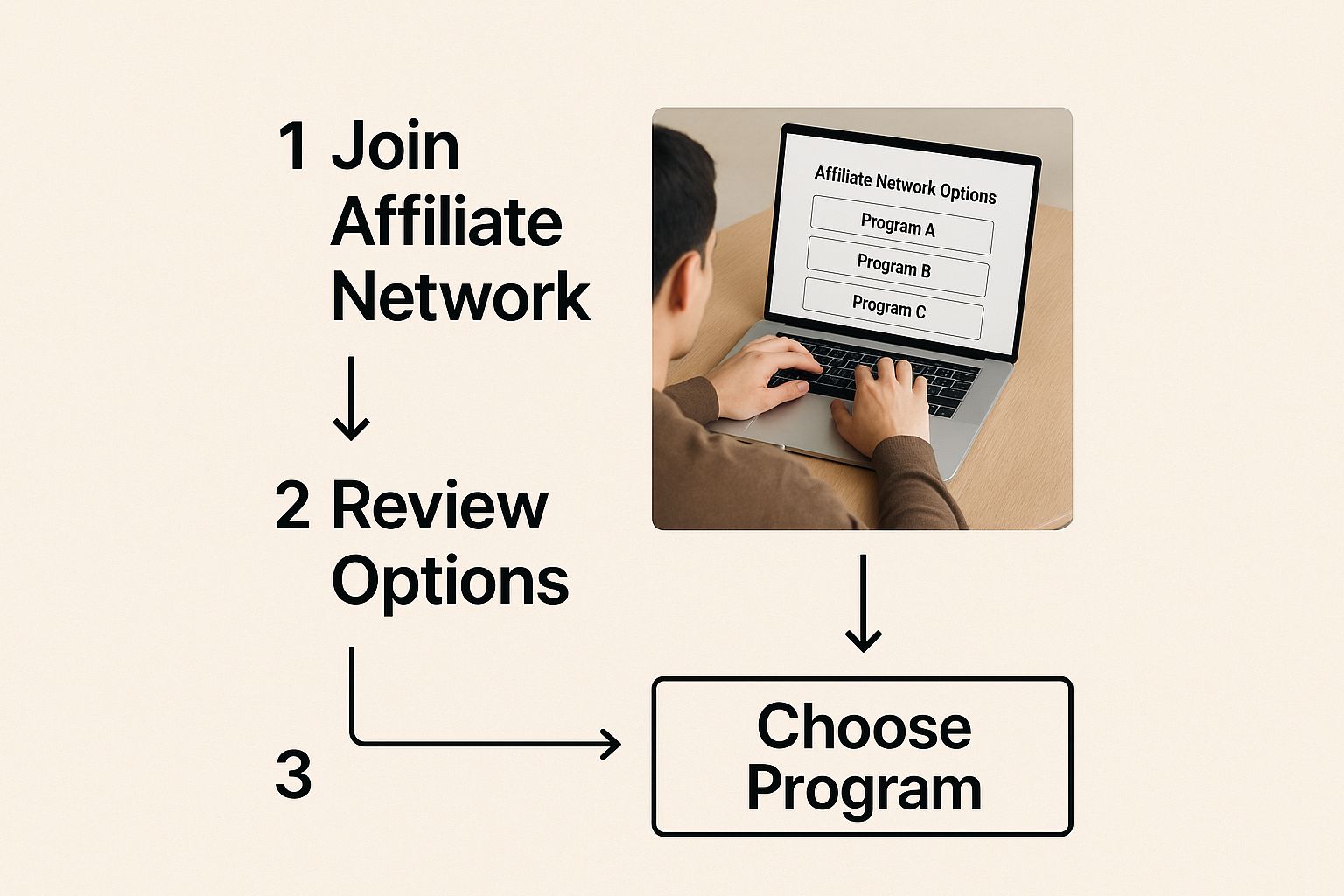At its most basic, creating an affiliate link is simple. You join a program, pick a product to feature, and the company gives you a special, trackable URL. That link has a unique ID tied directly to you, making sure you get credit when someone buys through it.
But just grabbing a link isn't enough if you want to make real money.
Understanding How Affiliate Links Really Work
Before we jump into the how-to, let's pull back the curtain on what’s actually happening when someone clicks your link. Think of it less like a simple URL and more like a digital handshake that tells a brand, "Hey, this customer came from me!" This is the core engine of affiliate marketing, and it's a massive one.
The numbers don't lie. The affiliate marketing industry is on track to hit a staggering $18.5 billion in 2025 and is expected to grow to $31.7 billion by 2031. It’s no wonder that over 80% of advertisers rely on affiliate programs to drive sales. If you're curious about the data, Hostinger's latest statistics paint a pretty clear picture of the opportunity here.
The Anatomy of a Tracking Link
So, what makes an affiliate link tick? It’s really just two key pieces working together: the standard product URL and a string of unique tracking parameters. These parameters are where the magic happens—they contain the specific codes that identify you as the referrer.
Let’s break that down:
- Base URL: This is just the normal web address for the product page, like
https://brand.com/product-page. - Tracking Parameters: This is everything that comes after the question mark (
?). It includes your affiliate ID and can also have other useful tags, like a campaign name or a source to show where the click came from (your blog, a newsletter, etc.).
A typical link might look something like this: https://brand.com/product?ref=yourID123&utm_source=blog.
In that example, ref=yourID123 is your personal tracking code that assigns the sale to you. The utm_source=blog bit is extra data that tells you the click came from your blog, which is incredibly useful for figuring out what's working.
This visual shows how it all fits together.
As you can see, those extra parameters get tacked onto the end of the URL, creating a unique link that tracks every click and sale back to your account.
To make this even clearer, here’s a quick table breaking down the essential parts of a high-performing affiliate link.
Anatomy of a High-Performing Affiliate Link
| Component | Purpose | Example |
|---|---|---|
| Base URL | The destination page for the product or service. | https://www.examplebrand.com/special-offer |
| Parameter Separator | A ? that signals the beginning of tracking data. |
? |
| Affiliate ID | The unique code that identifies you as the referrer. | ref=yourID123 |
| Parameter Connector | An & used to add more tracking parameters. |
& |
| Campaign/Source Tag | Optional data to track where the click originated. | utm_source=newsletter |
Understanding these pieces is what separates amateur affiliates from the pros. It's the difference between just dropping links and building a real strategy.
Different Programs, Different Structures
It’s also worth noting that not all affiliate links look identical. Big players like Amazon Associates often use shorter, more complex-looking links with a bunch of different parameters. On the other hand, a lot of SaaS companies using platforms like Refgrow tend to provide cleaner, more customizable URLs that are a bit easier on the eyes.
The real takeaway here is that understanding these components is your key to moving beyond just pasting links. It empowers you to build a strategic, performance-driven marketing plan where you can track, analyze, and optimize every single link for maximum conversions. Knowing how your links work is the first real step toward earning meaningful commissions.
Generating Your First Link in Refgrow
Alright, let's roll up our sleeves and move from theory to action. I'm going to walk you through exactly how to create your first affiliate link right inside the Refgrow dashboard. This isn't just about spitting out a generic URL; we're crafting a link that’s built to perform from the get-go.
It's a great time to be honing these skills. The affiliate marketing world is exploding—in the U.S. alone, spending hit around $9.56 billion in 2023. Forecasts suggest it could soar to nearly $15.8 billion by 2028. That's a massive 65% jump in just five years, which shows why getting your links right is more important than ever.
Create Deep Links That Actually Convert
One of the biggest mistakes I see new affiliates make is sending traffic to a generic homepage. Don't do it. Always create a deep link that points users to a specific product or landing page.
This small tweak makes a huge difference. It gives your audience a much smoother experience and can seriously boost your conversion rates by cutting out extra clicks. Think about it: if you’re promoting a new software feature, your link should land people directly on that feature's page, not the company's "About Us" section.
The first step, as you can see below, is picking the right program or product to promote from your network. This choice is everything—if you pick something your audience loves, the rest of the process becomes so much easier.

Add Custom Tracking IDs to Know What Works
Once you have your destination URL, the next move is adding tracking identifiers, and Refgrow makes this super straightforward. These custom IDs, often called "SubIDs," allow you to tag your links so you can see precisely which campaigns are driving clicks and, more importantly, sales.
This level of detail is a total game-changer. For example, you can create unique tags to see how different channels perform:
- Use
winter_promo_emailfor a link in your December newsletter. - Tag a link with
q1_blog_postfor a specific article. - Use
sidebar_bannerfor a call-to-action on your website.
Without these tags, all your traffic just gets jumbled together. You'd have no real idea what’s working and what's wasting your time. Nailing this down is a huge part of learning how to get affiliates to bring in consistent revenue.
Pro Tip: Make custom tracking IDs non-negotiable. Data is what separates the pros from the hobbyists. The more you track, the smarter you can get with your strategy.
The screenshot below shows you exactly where to plug in your destination URL and add a custom tracking ID within the Refgrow platform.

See how simple that is? Clear fields for the landing page and the tracking tag. Just fill those in, hit "Create Link," and you're set. You've now got a perfectly optimized, trackable affiliate link ready to share.
Placing Your Links for Maximum Impact

You’ve created the perfect, trackable affiliate link. Great. But that's only half the battle. A link is worthless if it's hidden where no one will ever see it. The real skill lies in strategic placement—turning that simple URL into a natural part of the conversation you're having with your audience.
The goal is to weave your links into your content so seamlessly that they feel like a helpful recommendation, not a blatant sales pitch. This is non-negotiable in today's market. Authenticity is everything. Affiliate marketing has exploded, with worldwide searches for the term doubling since 2016 and over 80% of advertisers now running affiliate programs. You can dive deeper into this trend with these affiliate marketing statistics. This massive growth means audiences are savvier than ever; they can spot a lazy link placement from a mile away.
Weave Links Naturally into Your Content
The most effective place to start is right within your blog posts and articles. This is where anchor text—the clickable text in a hyperlink—comes into play. Please, avoid generic and uninspired phrases like "click here." They scream "advertisement" and do little to build trust.
Instead, opt for anchor text that’s descriptive and genuinely useful. For instance, rather than linking from "our favorite tool," try something more compelling like "our go-to tool for automating social media posts." See the difference? The second option tells the reader exactly what they're getting and why it's relevant, framing the link as a genuine solution.
Beyond the Blog Post: Other High-Converting Spots
In-content links are your bread and butter, but don't stop there. If you only place links inside articles, you're absolutely leaving money on the table. Think about expanding your strategy to include these high-impact locations:
- Dedicated Resource Pages: A "Tools I Use" or "My Gear" page is a goldmine. It acts as a trusted, one-stop shop for your audience, driving consistent, high-intent clicks over time.
- Eye-Catching Call-to-Action Buttons: For your top-tier affiliate offers, a simple text link often isn't enough to grab attention. Use visually distinct buttons with strong, action-oriented copy like "Try Refgrow for Free" or "Get the Ultimate Toolkit." Buttons draw the eye and guide the user toward the click.
- Email Newsletters: Your email list is a direct channel to your most loyal followers. When you share a case study, a special discount, or just a weekly roundup, you have the perfect opportunity to include relevant affiliate links.
Don't just paste links; place them with purpose. The right link in the right place at the right time feels less like an ad and more like a solution to your reader's problem.
A Quick Word on Compliance: Nofollow Attributes
This part is important. When you’re using paid links, it's a non-negotiable best practice to add a rel="nofollow" or rel="sponsored" attribute to your HTML. This is a signal to search engines that the link is an advertisement and that they shouldn't pass any "link equity" through it. It keeps you on the right side of Google's guidelines.
Here’s what that looks like in simple HTML:
<a href="https://your-affiliate-link-here.com" rel="sponsored">Check out this amazing tool</a>
Don't worry, you don't have to do this manually every time. Many WordPress plugins, like ThirstyAffiliates, can be configured to automatically add these attributes to all your affiliate links, making compliance a breeze. Marrying smart placement with sound technical practices is how you build a sustainable and successful affiliate strategy.
How to Manage and Optimize Your Links

Getting your affiliate links out there is just the first step. The real money in affiliate marketing comes from what you do after you hit "publish." Top earners don't just create links; they treat them like business assets, constantly checking in on them and tweaking their strategy.
If you just set them and forget them, you're leaving cash on the table.
The whole process starts with digging into your analytics. Inside Refgrow, you have all the data you need to see what’s working and what isn't. The most important numbers to watch are your clicks, conversion rates, and of course, your total earnings.
Pinpoint Your Top Performers
Your first job is to figure out which links are actually making you money. Is it that link buried in a deep-dive product review? The one in your email signature? The data holds the answer.
Once you’ve identified your winners, you need to understand why they’re performing so well. This is where you put on your detective hat. If a particular article is converting like crazy, maybe you should create more content around that product or push that specific post harder on social media. This data-first approach is the key to figuring out how to increase affiliate sales over time.
The Takeaway: Your best-performing links are a roadmap. They show you exactly what your audience responds to. Don't just celebrate their success; deconstruct it so you can apply the same winning formula elsewhere.
Essential Link Maintenance and Hygiene
Beyond just tracking performance, you need to do some regular housekeeping. Nothing kills your momentum—and your audience's trust—faster than a dead link. Products get discontinued, and landing pages change. If your links don't work, you don't get paid.
Here’s a quick rundown of some good habits to get into for managing your links effectively.
- Cloak Your Links: Using a tool like ThirstyAffiliates helps turn long, ugly affiliate URLs into clean, professional-looking links (like
yoursite.com/recommends/product). It looks better, builds trust, and makes it incredibly easy to update a link in one place and have it change everywhere on your site. - Check for Broken Links: At least once a quarter, you should run a check for broken links across your site. There are plenty of plugins and online tools that can automate this for you. It's a simple task that prevents lost commissions.
- Refresh Outdated Links: Offers change. Products get updated. Make it a habit to revisit your older, high-traffic posts and swap out old links for new ones. This keeps your content fresh and your income stream healthy.
Staying on top of your links isn’t the most glamorous part of affiliate marketing, but it’s absolutely essential for building a reliable, long-term business. A little bit of routine maintenance goes a long way.
Here’s a simple table summarizing these core tasks. Think of it as your link health checklist.
Essential Link Management Practices
| Task | Why It's Important | Recommended Frequency |
|---|---|---|
| Performance Review | Identifies top-performing content and reveals what your audience truly values. | Weekly |
| Broken Link Check | Prevents lost commissions and ensures a good user experience for your readers. | Quarterly |
| Link Cloaking | Simplifies management by centralizing links and improves click-through rates. | As you create links |
| Content Refresh | Keeps your recommendations relevant and ensures you're promoting the best, current offers. | Annually (for top posts) |
By building these practices into your regular workflow, you move from simply placing links to strategically managing a portfolio of revenue-generating assets. It's a small shift in mindset that can have a huge impact on your bottom line.
Common Mistakes That Kill Conversions
Just because you can create affiliate links in seconds doesn't mean they'll actually make you money. I've seen countless affiliates make the same simple mistakes that completely sabotage their earnings and, worse, damage their credibility.
Getting this right isn't about some secret formula. It’s about avoiding the obvious traps that new and even some seasoned affiliates fall into. Let's walk through them.
Hiding Your Affiliate Relationship
This is a big one. Failing to disclose that you earn a commission is not just shady—it's against the law. The FTC has clear guidelines on this, and trying to hide your affiliate status is the quickest way to break your audience's trust.
People are smart. They know what an affiliate link looks like. Just be upfront about it. A simple, clear disclosure builds trust and shows you respect your audience. They'll appreciate the honesty.
Using Weak, Generic Anchor Text
Nothing screams "lazy marketing" like a link that just says "click here." It’s uninspired, a bit pushy, and tells your reader absolutely nothing about where they're going.
Let's look at a real-world example:
Before: "To get the tool, click here."
After: "We use this content optimization tool to plan all our articles."
See the difference? The second one is helpful. It tells the reader exactly what the tool is and why you're recommending it, making the link feel like a genuine part of the content, not an ad.
Promoting Products You Don't Actually Use
This is the fastest way to destroy your reputation. If you're promoting a product you've never touched just to chase a commission, your audience will see right through it. Authenticity is everything in this game.
Your followers trust you because they believe in your judgment. Recommending a bad product for a quick buck will burn that trust forever. Only recommend tools and services you personally use and can vouch for.
When you build your program on a foundation of genuine recommendations, you create a loyal audience that listens to what you have to say. For anyone building a program from the ground up, our guide on how to create an affiliate program is the perfect starting point.
The rule I live by is simple: provide genuine value first. Spamming links without context or a real solution to a reader's problem doesn't just fail to convert—it actively annoys people and drives them away.
Forgetting About the User Experience
Think about how your links affect the reader's journey. Have you ever landed on a page that was just a wall of affiliate links? It's overwhelming and feels less like a helpful article and more like a desperate sales pitch.
Don't be that person.
- Be strategic: Pick only the most relevant, helpful products to link to.
- Add your insight: Back up every link with your own experience or useful information.
- Find the right balance: Weave your links into the content naturally, without sacrificing readability.
Focus on creating a fantastic, helpful experience for your reader. When you do that, the conversions will take care of themselves.
Common Questions About Affiliate Links (Answered)
As you start getting your hands dirty with affiliate links, you’ll quickly run into a few common questions. It can feel like there's a lot to navigate, but don't worry—most of the answers are pretty straightforward. Let's tackle some of the things that trip people up the most.
Right off the bat, many people wonder about the difference between a standard link and a deep link. Think of it this way: a standard link drops your visitor off at a company's front door (their homepage). A deep link, on the other hand, takes them directly to the specific product or offer page they're interested in.
Whenever you have the choice, go with the deep link. It makes the customer's journey much shorter and almost always leads to better conversion rates.
Do I Really Need to Disclose My Links?
This is a big one, and the answer is a resounding yes. You absolutely have to disclose your affiliate relationships. The Federal Trade Commission (FTC) has very clear guidelines that require you to be transparent anytime you could earn a commission from a link.
But this isn't just about staying on the right side of the law. Honesty is how you build trust. When your audience knows you're being upfront about your partnerships, they're far more likely to take your recommendations seriously. A simple, clear statement like, "This post contains affiliate links," usually does the trick.
Let's be clear: transparency is a win-win. It protects your audience, builds your credibility, and puts your entire affiliate strategy on solid ethical ground. Hiding your affiliations is one of the fastest ways to burn the trust you've worked so hard to build.
What's the Deal with Link Cloaking?
Link cloaking is another term that sounds more complicated than it is. It's simply the practice of taking a long, messy affiliate URL and transforming it into a clean, branded link using your own domain. For example, turning affiliateprogram.com/products/?product_id=123&affiliate=xyz into something like yoursite.com/recommends/product.
So, is it a good idea? When done right, it's a fantastic practice. Cloaking your links has some real advantages:
- It Looks More Professional: A branded link feels more trustworthy than a long URL filled with tracking parameters.
- It's Easier to Manage: If an affiliate program ever changes its link structure, you can update it in one central dashboard instead of digging through dozens of old blog posts to fix broken links.
- You Get Better Data: Many link cloaking tools come with built-in analytics, giving you another layer of insight into which links are actually getting clicks.
How Many Links is Too Many?
Finally, people always ask about link density. While there isn't a single magic number, the real goal is to find a balance between monetization and a great user experience. Your content's primary job is to provide value; the affiliate links should feel like natural, helpful resources within that content.
A good rule of thumb is to only add a link where it genuinely helps the reader. If you read your article and it feels more like a sales page than a helpful guide, you've probably overdone it. Always focus on quality over quantity. Your audience—and your commission reports—will thank you for it.
Ready to put these best practices to work with a tool that handles all the heavy lifting? Refgrow gives you everything you need to launch, manage, and grow your affiliate program right inside your SaaS product. Start your journey with Refgrow today.

